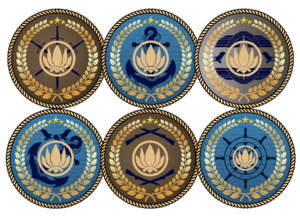Commonwealth Self-Defense Forces
| Commonwealth Self-Defense Forces | |
|---|---|
| 联邦自卫队 Liánbāng Zì Wèiduì | |
 Seals of the six service branches of the Commonwealth Self-Defense Forces | |
| Founded | June 1st, 1887 |
| Current form | September 15th, 1935 |
| Service branches | |
| Headquarters | The Round Table, Hebing |
| Leadership | |
| Commander-in-Chief | Wu Mingzhi |
| Administrator of the Military | Mamoru Sano |
| Chairman of the CSDF High Command | Sun Fangyu |
| Personnel | |
| Military age | 18 |
| Conscription | Provided by law but never implemented |
| Available for military service | 30 million males, age 15–49, 28 million females, age 15–49 |
| Fit for military service | 55 million males, age 15–49, 45 million females, age 15–49 |
| Active personnel | Est 1,450,000 |
| Reserve personnel | Est 2,200,000 |
| Deployed personnel | 5.000 |
| Expenditure | |
| Budget | cR 500 Billion |
| Percent of GDP | 5.89% |
| Industry | |
| Domestic suppliers | |
| Foreign suppliers | |
| Related articles | |
| History |
|
The Commonwealth Self-Defense Forces (Myrian: 联邦自卫队, romanized: Liánbāng Zì Wèiduì, abbreviated CSDF) is the unified armed forces of the Commonwealth of Aldia and encompasses the Army, Navy, Air Force, Marine Corps, Maritime Protection Forces & Territorial Forces. The CSDF is administered by the Commonwealth Military Administration whereas the Chancellor of the Commonwealth serves as its commander-in-chief. When it was first established, the CSDF did not have any active duty personnel in peace time, instead member states of the Commonwealth would only contribute forces when war has been declared. Command was also decentralized which hindered cohesion amongst the various armed forces of the Commonwealth, each of whom had different standards and doctrines. The Military Reform Act of 1935 saw the integration of all armed forces of the Commonwealth's armed forces into a singular cohesive organization.
Conscription is provided by law although the CSDF has been able to maintain a reasonable number of personnel without resorting to a draft. There are approximately eighth hundred thousand active CSDF personnel, this excludes civilian employees who work within the Commonwealth Military Administration. The Commonwealth Territorial Forces, the CSDFs' organized militia component, is the largest branch of the CSDF and is also considered as the CSDF's reserve components. Currently more than one million citizens are registered as fully-trained members of the Commonwealth Territorial Forces. The CSDF is supported by many domestic defense contractors to supply it with state-of-the-art equipment. The CSDF has been involved in a number of conflicts since its inception, most notably the Wuxian Unrest, the Shukaku Rebellion, the Myrian Canal Conflict & involvement the Third Voshan War.
Role
The primary roles of the Commonwealth Self-Defense Forces are as follows:
- To defend the Commonwealth from threats both foreign & domestic
- Ensure that components of the armed forces are well maintained & developed to contend with any challenges
- Lead & participate in humanitarian & peacekeeping missions in the Myrian region
Doctrine
The combat doctrine of the Commonwealth Self-Defense Forces has shifted through time. Initially the CSDF was established not as a standing army but rather as a command structure that will coordinate the armed forces of the Commonwealth's member states. As a consequence the Commonwealth had no standing army during peace time. Armies were only fielded during times of war but due to the different standards & combat doctrines between each member state the effectiveness of the early CSDF was extremely limited. This limitation was eliminated with the Military Reform Act of 1935 which disbanded the armed forces of individual member states and established a centralized standing army & command structure.
History
Establishment
Shikaku Rebellion
Myrian Canal Conflict
Third Voshan War
Service Branches
Army
With approximately 600,000 personnel, the Commonwealth Army is the largest service branch of the CSDF and is supported by the Army Reserves and numerous paramilitary organizations. The Army fulfills several roles such as but is not limited to; armored infantry, air assault, mechanized warfare and combined arms warfare. While not as large as its counterparts in the northern hemisphere the Army has invested heavily in technological elements & mechanization of its units such as but not limited to: electronic warfare units, unmanned aerial vehicles, army aviation & long-range precision strike weapons. Its primary responsibility is to serve as the nations primary land service branch of the armed forces. It is headed by the Commander of the Army, a member of the CSDF High Command. The Army is also one of the oldest service branches of the CSDF, established in 1887.
Main Article: Commonwealth Navy
The Commonwealth Navy is the naval component of the CSDF and with 350,000 personnel it is the second largest service branch. When it was first established the Navy only had Green Water capabilities, only capable of projecting power within the Myrian region and slightly beyond the nations Exclusive Economic Zone. With the commissioning of the Taifeng-class Landing Helicopter Dock the Commonwealth Navy has firmly became a Blue Water navy with limited global-reach power projection capabilities. The Navy's combat force is divided into three main sub-branches: Surface Force, Submarine Force & Naval Aviation. The Commonwealth Navy is divided into three major area commands: East, West & South Fleet Commands and is headed by the Fleet Admiral of the Navy, a member of the CSDF High Command.